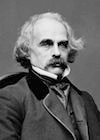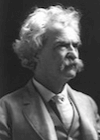Off on a Comet
by Jules Verne
Introduction
AMONG so many effective and artistic tales of our author, it is difficult to give a preference to one over all the rest. Yet, certainly, even amid Verne's most remarkable works, his "Off on a Comet" must be given high rank. Perhaps this story will be remembered when some of his greatest efforts have been obliterated by centuries of time. At least, of the many books since written upon the same theme as Verne's, no one has yet equaled or even approached it.
In one way "Off on a Comet" shows a marked contrast to Verne's earlier books. Not only does it invade a region of remotest space, but the author here abandons his usual scrupulously scientific attitude and gives his fancy freer rein. In order that he may escort us through the depths of immeasurable space, to show us what astronomy really knows of conditions there and upon the other planets, Verne asks us to accept a situation which is in a sense self-contradictory. The earth and a comet are brought twice into collision without mankind in general, or even our astronomers, becoming conscious of the fact. Moreover several people from widely scattered places are carried off by the comet and returned uninjured. Yet further, the comet snatches and carries away with it for the convenience of its travelers, both air and water. Little, useful tracts of earth are picked up and, as it were, turned over and clapped down right side up again upon the comet's surface. Even ships pass uninjured through, this remarkable somersault. These events all belong to the realm of fairyland.
If the situation were reproduced in actuality, if ever a comet should come into collision with the earth, we can conceive two scientifically possible results. If the comet were of such attenuation, such almost infinitesimal mass as some of these celestial wanderers seem to be, we can imagine our earth self-protective and possibly unharmed. If, on the other hand, the comet had even a hundredth part of the size and solidity and weight which Verne confers upon his monster so as to give his travelers a home―in that case the collision would be unspeakably disastrous—especially to the unlucky individuals who occupied the exact point of contact.
But once granted the initial and the closing extravagance, the departure and return of his diameters, the alpha and omega of his tale, how closely the author clings to facts between! How closely he follows, and imparts to his readers, the scientific probabilities of the universe beyond our earth, the actual knowledge so hard won by our astronomers! Other authors who, since Verne, have told of trips through the planetary and stellar universe have given free rein to fancy, to dreams of what might be found. Verne has endeavored to impart only what is known to exist.
In the same year with "Off on a Comet," 1877, was published also the tale variously named and translated as "The Black Indies," "The Underground City," and "The Child of the Cavern," This story, like "Round the World in Eighty Days" was first issued in "feuilleton" by the noted Paris newspaper "Le Temps." Its success did not equal that of its predecessor in this style. Some critics indeed have pointed to this work as marking the beginning of a decline in the author's power of awaking interest. Many of his best works were, however, still to follow.
Return to the Off on a Comet Summary Return to the Jules Verne Library









